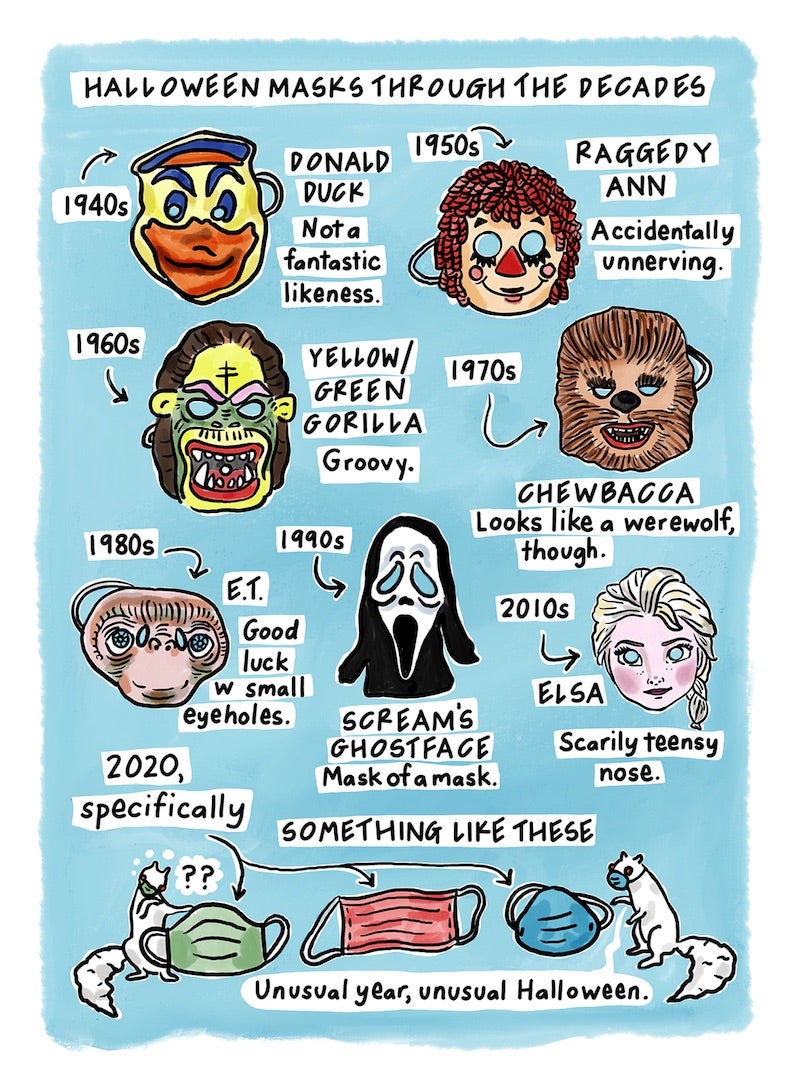ObieSafe Weekly: October 27, 2021
October 27, 2021 8:00 AM
Office of Communications

Illustration

Transcription
Halloween Masks Through the Decades
- 1940s, Donald Duck. Not a fantastic likeness.
- 1950s, Raggedy Ann. Accidentally unnerving.
- 1960s, yellow/green gorilla. Groovy.
- 1970s, Chewbacca. Looks like a werewolf, though.
- 1980s, ET. Good luck with small eyeholes.
- 1990s, Scream's ghost face. Mask of a mask.
- 2010s, Elsa. Scarily teensy nose.
- 2020, specifically. Something like these. (Colorful covid masks presented by white squirrels.) Unusual year, unusual Halloween.
COVID-19 Booster update
The Center for Disease Control (CDC) and the Food and Drug Administration (FDA) approved all three COVID-19 vaccines as boosters. What does this mean for Obies?
The following summarizes CDC recommendations:
- Anyone who is 18 years or older who initially received the Johnson & Johnson COVID-19 vaccine should receive a booster shot two months or more after the initial dose.
- These individuals are eligible to receive the COVID vaccine of their choice, including J&J, Moderna, or Pfizer.
- According to a trial study discussed in Yale Medicine, preliminary data showed that people who received the J&J vaccine followed by a Moderna booster had a 76-fold rise in antibodies in 15 days; those who got Pfizer saw a 35-fold increase; while those who got the J&J booster had only a four-fold increase. That data was published in a preprint and has not yet undergone independent peer review.
- For individuals who received an initial vaccine of Pfizer-BioNTech or Moderna COVID-19 vaccine, the following groups are eligible for a booster shot at 6 months or more after their initial series:
- 65 years and older
- Age 18+ who have underlying medical conditions
- Age 18+ who work or live in high-risk settings
- Eligible individuals may choose which vaccine they receive as a booster dose. Some people may have a preference for the vaccine type that they originally received, and others may prefer to get a different booster. CDC’s recommendations now allow for this type of mix and match dosing for booster shots.
Mark Adams, Deputy Health Commissioner, was asked if Oberlin students who received Moderna or Pfizer, were eligible for a booster given that they live in a “high risk setting,” such as residence halls.
Mr. Adams said that students with health issues that place them at risk are eligible. Students that live in a multiple student room may be considered eligible. “There is no verification process but, as a reminder to the students, their immunity is really, really good right now and for those who truly are at risk, they can receive a booster. But there’s no reason to rush or stand in a line. The booster will be available when they are ready.”
The Lorain Public Health Department will be holding clinics most of November and probably into December and beyond.
The CDC points out that available data right now show that all three of the COVID-19 vaccines approved or authorized in the United States continue to be highly effective in reducing risk of severe disease, hospitalization, and death, even against the widely circulating Delta variant. Vaccination remains the best way to protect yourself and reduce the spread of the virus and help prevent new variants from emerging.
Oberlin is currently in discussion with the Lorain Public Health Department regarding offering a COVID-19 vaccination clinic on campus. Watch for future communications!
Good news on the COVID front
Although Ohio and Lorain County remain areas of high COVID transmission, the trends are promising. The Ohio Department of Health website, which is updated daily, shows that current trends in Ohio are improving. There were 2,540 cases reported on October 24, 2021, which is well below the 21-day average of 4,386. The highest case number in the last 21 days was on October 8 with 6,651 documented cases.
Lorain County trend data is also promising. Cases are down 25.4 percent over the last seven days, with hospitalizations down 18.7 percent.
What does this mean for Oberlin? This downward trend in COVID infections, when coupled with the campus’ 96 percent overall vaccination rate and 0.2 percent positivity rate, means that Oberlin continues to be a very safe place to learn, work, and live.
COVID-19 is here to stay but, with common sense precautions, let the primary focus be enjoying your time at Oberlin. There are many, including the ObieSafe team and Student Health, who continue to monitor the COVID situation and will inform you of important public health updates. In the meantime, continue to diligently adhere to the indoor mask mandate; wash your hands; monitor your symptoms, and contact Student Health if you have serious symptoms. A COVID test may not be necessary so please follow the guidance of Student Health. Resources can then be prioritized for those in need of health services.
Get in touch with the ObieSafe team
Have something to share in a future issue of ObieSafe Weekly? Email obiesafe@oberlin.edu with story ideas or information you’d like to have considered for publication.